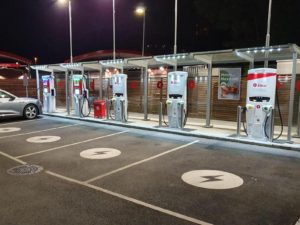With rapid and ongoing improvements in vehicle charging speeds, should we be setting higher expectations for the speed of Canada’s electric vehicle fast chargers?

At this Circle K in Fjellhamar, Norway, there is a mix of 150kW electric vehicle chargers on the left and 50kW on the right. Photo: PlugShare
With rapid and ongoing improvements in vehicle charging speeds, should we be setting higher expectations for the speed of Canada’s electric vehicle fast chargers?
Electric vehicle adoption in Canada is growing at an exponential rate. EVs sales recently exceeded 3.5 per cent of total sales, taking the number of EVs on the road to about 120,000. The growth rate is 28 per cent nationally and more than 150 per cent in certain provinces. If EVs imported from the U.S and sold as used vehicles are included, the number is even higher.
The level of EV adoption isn’t the only thing that is rapidly changing: charging technology and vehicle charging capacity are as well. And right now, that presents an opportunity for Canada’s EV charging infrastructure to leap ahead.
When it comes to charging, the closest gas station equivalent — known as Direct Current Fast Charging (DCFC) — typically provides a charging rate of 50kW through a CHAdeMO or CCS Combo connector. That rate has been the norm for the past decade, reflecting the capacity of older-era EVs to charge at a maximum rate of 50kW.
Speeds up, times cut

However, all leading EV models now accept a DCFC charging rate of 75kW to 150kW or more. Likewise, we are now seeing DCFC stations capable of delivering charging speeds from 50kW up to 350kW, sometimes referred to as High Power Charging (HPC). In combination, this technology has cut charging times to as little as 10 or 20 minutes.
HPC systems aren’t just faster. They’re also configured differently. In a typical 50kW DCFC installation, the charging unit is integrated within each charging station. An HPC service, on the other hand, is designed like a gas station (where one storage tank feeds multiple pumps) with a centralized power-unit feeding one or multiple user-units.
This HPC design allows lower cost future expansion for a site where multiple DCFC charging stations are planned. It is an approach adopted by Tesla with its proprietary supercharger network, but we are now also seeing others following suit with Ionity, Circle K and Fastned in Europe. In North America, Electrify America has started using this approach but is still in testing before mass deployment, while Electrify Canada’s first installation, in Ontario, is an HPC station capable of a 75-350kWh charging rate.
The future is today
Despite the emergence of HPC systems, many new DCFCs are still 50kW chargers. The main reason installers are sticking with 50kW stations is cost. A 150kW charger is significantly more expensive up front.
Yet because at this point every new charging station is being subsidized with federal incentives through NRCAN (up to $50,000 per charger), this means the government is paying for new stations that, in at least some circumstances, may not be optimal for the lifetime they are intended to serve. It also means drivers with new EVs that are capable of a 20-minute charge are often having to settle for a 40-minute charge (and possibly wait longer in line) due to a lack of HPC infrastructure.
This isn’t to say 50kW DCFCs don’t still have a place. In low-traffic areas or remote areas where power is limited and there isn’t as much demand, they’re still appropriate. Likewise, if it’s a single station at a community centre or grocery store where users are going to be there for 30 minutes or an hour, they make sense. But for any installation in a potentially high-volume area, and where expansion in the future is likely, it just makes sense to take a future-proofing approach with a higher-power, expandable system rather than one where any upgrade means starting over from scratch.
Revise the terms
The two rounds of NRCAN funding for charging stations to date has been a great program. But moving forward, assuming the newly elected government intends to continue supporting new charging infrastructure, there’s a strong argument that it revise the program’s terms to require DCFC charging infrastructure in an HPC design format. Such a change would move us beyond the current “quick fix” mindset around EV charging infrastructure and be a sign of bigger aspirations. After all, we are building a charging network to power Canada’s future.

Maxime Charron is the founder of LeadingAhead Energy and board member of Electric Mobility Canada.






